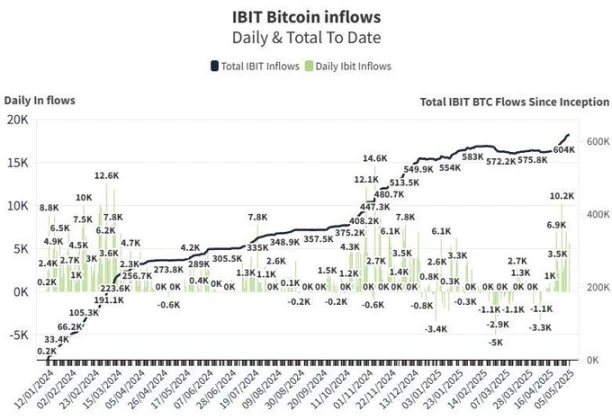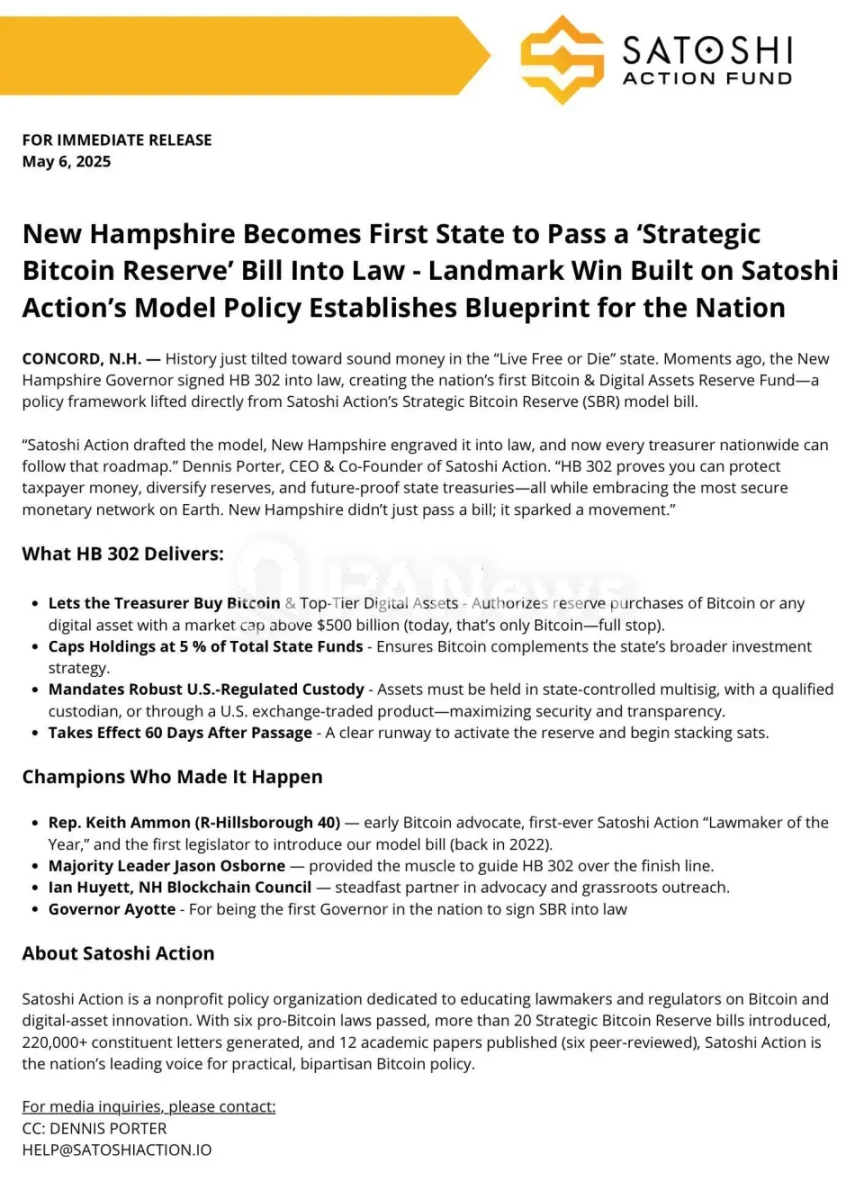Original Author: Bright, Foresight News
On the morning of May 7, the cryptocurrency market rebounded from the consecutive declines at the end of the May Day holiday, with the secondary market following BTC's rise. BTC surged from a low of $93,390 yesterday to $97,732, an increase of over 4.4%, recovering nearly five days of losses. As of the time of writing, Bitcoin is reported at $96,866.
ETH rose from $1,751.45 to $1,850, a gain of 5.6%. SOL started from $141.41 and peaked at $149.54, an increase of 5.74%.
The total market capitalization of cryptocurrencies rebounded by over 2%, breaking through the $3 trillion mark again. Bitcoin's market share surpassed 65%, reaching a new high since January 2021. The Fear and Greed Index climbed to 67, indicating greed. Meanwhile, cryptocurrency stocks in the U.S. rose in after-hours trading, with Coinbase recovering to $200, up 1.58%; MicroStrategy closed at $393.89, up over 2.15%.
In terms of liquidation data, according to Coinglass, over 137,600 people were liquidated in the last 24 hours, with a total liquidation amount of $311 million, affecting both long and short positions. In the last hour, liquidations totaled $40.97 million, with short positions accounting for $38.002 million. The largest single liquidation on CEX was ETH-USDT, occurring on Binance, valued at $8.053 million.
What exactly catalyzed the sharp rise in the cryptocurrency and global risk asset markets this morning?
On May 7, the Chinese Ministry of Foreign Affairs announced that Vice Premier He Lifeng would visit Switzerland from May 9 to 12, during which he would hold talks with U.S. officials. This news significantly boosted risk appetite, with the renminbi briefly rising over 100 points to break 7.20. The three major U.S. stock indices surged, with Nasdaq futures rising over 1%. Spot gold fell over 1.9%, hitting a daily low of $3,370 per ounce.

Tariff Stick Difficult to Sustain
The subtle shift in U.S.-China relations has become a key turning point for market sentiment. Following the Trump administration's imposition of a 104% tariff on Chinese goods in April, which triggered severe volatility in global risk assets, the Chinese Ministry of Foreign Affairs announced on May 7 that Vice Premier He Lifeng would visit Switzerland from May 9 to 12 for formal talks with U.S. Treasury Secretary Janet Yellen and Trade Representative Katherine Tai. This marks the first face-to-face discussions on economic and trade issues between high-level officials from both countries since the 2024 G20 summit, interpreted by the market as a clear signal to "pause tariff escalation."
Historical data shows that during the January 2024 U.S.-China trade negotiation window, Bitcoin rose 22% in a single month due to improved expectations for cross-border capital flows. Moreover, in the 48 hours leading up to this news, the cryptocurrency market had already begun to digest the sentiment of tariff suppression—on May 6, when U.S. stocks plummeted, BTC only slightly declined by 0.3%, significantly lower than the Nasdaq's 0.87% drop, demonstrating a "desensitization" to geopolitical risks.
The latest data released by the U.S. Department of Commerce on May 6 showed that the U.S. trade deficit surged to $123.4 billion in March, the highest level on record since 1992, primarily due to companies stockpiling imported goods ahead of the tariff implementation. This data forced the Trump administration to reassess the actual effectiveness of its "tariff pressure" strategy.
According to a Bloomberg report citing an internal White House memo, if the current tariff rates are maintained, U.S. retailers' annual profits could shrink by 15%, and inflation could rebound to 5.5%. "The marginal improvement in tariff policy is essentially a process of global capital repricing 'de-dollarized' assets," noted Bitwise Chief Investment Officer Matt Hougan during a morning conference call. When the dollar's credit is damaged due to trade conflicts, BTC's "digital neutrality" becomes the optimal solution for cross-border value storage.
Institutional "Dollar-Cost Averaging," Policy Support
While the market is immersed in the short-term positive explosion of U.S.-China easing, institutions seem to have long been reshaping the cryptocurrency valuation system through "dollar-cost averaging in BTC." According to SoSoValue data, on May 6, the total net inflow into BTC spot ETFs was $425 million, with total net assets of BTC spot ETFs at $110.685 billion, and the ETF net asset ratio (market cap relative to total BTC market cap) reaching 5.91%, with a historical cumulative net inflow of $40.662 billion.
According to Lookonchain monitoring, on May 6, BlackRock's BTC spot ETF (iShares Bitcoin Trust ETF) purchased another 5,613 BTC, valued at approximately $529.5 million, bringing its total holdings to 620,252 BTC, worth about $5.851 billion. Since April 21, BlackRock has accumulated a total of 47,064 BTC, valued at approximately $4.44 billion. Moreover, in the past week, BlackRock's ETF has seen daily targeted inflows of $500 million, raising market speculation about its "high-position accumulation" behavior.

On the policy front, good news has emerged regarding state-level cryptocurrency strategic reserves in the U.S. New Hampshire Governor Chris Sununu signed HB302, the first state bill in the U.S. to designate cryptocurrency as a strategic reserve. This means that the New Hampshire State Treasurer will invest up to 5% of state government funds in precious metals and cryptocurrencies with a market cap of at least $500 billion. Based on New Hampshire's total budget of $15.4 billion, 5% would be approximately $770 million, and based on the general fund of $5.6 billion, 5% would be about $280 million. Therefore, the potential investment amount in cryptocurrency for the state ranges from $280 million to $770 million, setting a precedent for future state legislation to establish cryptocurrency strategic reserves.

Federal Reserve Meeting Still Buried in "Fuses"
Despite the short-term sentiment warming, the Federal Reserve's May interest rate decision remains like the "Sword of Damocles" hanging overhead. CME interest rate futures indicate that the current market sees only a 3.1% probability of a 25 basis point rate cut in May. The probability of a 25 basis point cut in June is only 65% (down 10 percentage points from the April peak), and the 10-year U.S. Treasury yield has accelerated its decline to 3.75%, reflecting investors' concerns about the "policy lag effect"—April's non-farm payrolls added 177,000 jobs, and the core PCE price index rose 4.7% year-on-year, indicating that the U.S. economy remains resilient, which may delay the timing of rate cuts.
The cryptocurrency market faces a delicate balance. If the Federal Reserve maintains interest rates, high funding costs may suppress risk asset valuations (historical data shows that for every 1% maintained in interest rates, Bitcoin's implied volatility will increase by 12%); if a dovish signal is released, BTC's logic as an "anti-inflation asset" will be rapidly reinforced.
The current market's point of divergence lies in the Federal Reserve's "rate cut rhythm." In the latest "Summary of Economic Projections" released by the Federal Reserve, 12 officials support only a 50 basis point cut by 2025, while 7 support a 100 basis point cut, forming a rare "hawk-dove standoff." As the traditional financial system falls into a "stagflation spiral" (stubborn inflation + slowing growth), Bitcoin's network effect (with daily active addresses reaching 12 million) and market cap (over $1.9 trillion) make it a "necessity" for institutions to hedge against policy risks. Notably, the Federal Reserve's overnight reverse repurchase scale has declined for three consecutive days to $1.2 trillion, indicating that the banking system's liquidity surplus issue is easing, which may indirectly affect the scale of leveraged funds in cryptocurrencies.
However, although BTC has risen above the $97,000 mark, its dominance surpassing 65% indicates a strong risk-averse sentiment. Combined with BTC's recent extremely low volatility, significant price fluctuations may occur after the Federal Reserve meeting. Whether Powell will "hawk" or "dove" this time will be crucial.
免责声明:本文章仅代表作者个人观点,不代表本平台的立场和观点。本文章仅供信息分享,不构成对任何人的任何投资建议。用户与作者之间的任何争议,与本平台无关。如网页中刊载的文章或图片涉及侵权,请提供相关的权利证明和身份证明发送邮件到support@aicoin.com,本平台相关工作人员将会进行核查。




